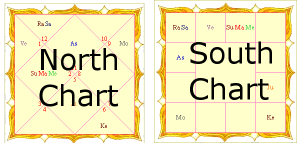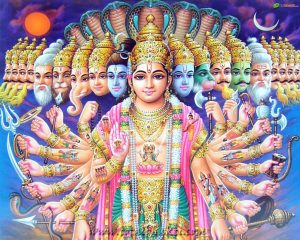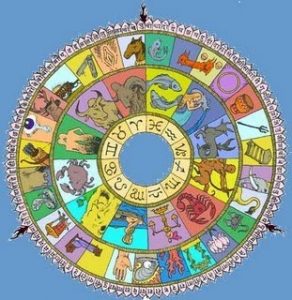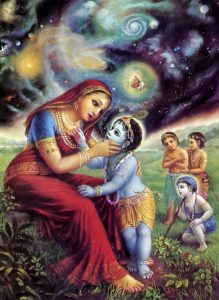We often hear devout Hindus say, “Hinduism is more than just a religion; It is a way of life.” While members of other religions also say the same thing––few devoted people want to think their religion is not a way of life––there is actually some justification for the Hindu statement. We can say this because Hindu culture has never fully separated its so-called “secular side” from its religious side, something that has taken place in many other religions as a result of the secularizing influence of modernity. We have noted this fact in reference to astrology. Hinduism still includes, not only religion, but also astronomy, astrology, grammar, mathematics, law, medicine, politics, diplomacy, war, love, architecture and many other branches of knowledge. In this way, Hinduism is holistic. It is not just about theology.
Vaastu Shastra
It is popular in many Western countries to hear about the ancient Chinese system of Feng Shui, which attempts to align the energies of the physical world with the life of man. The branch of Hindu learning that includes these ideas is called Vaastu Shastra, Hindu Architecture. In Sanskrit the word “vaastu” means a building or structure and so the expression “vaastu shastra” is the science of structure. Like Vedic astrology, vaastu is a vast and highly developed branch of learning and in this installment I can describe only the most basic principles of this subject. There are, of course, whole books devoted to this wonderful subject and an interested reader is encouraged to study these books, especially if one is planning to build or buy a home, commercial building or land for construction.
Hindu Architecture addresses two kinds of buildings: religious structures––temples and shrines––as well as non-religious structures, civic buildings, business complexes and residential homes. In Hindu culture, not only is the home and family important, but so is the actual building where the family lives. Consequently, how a physical building is designed and constructed is a matter of deep concern. Hindu traditions tell us that there are forces, some subtle and others not so subtle, some positive and some negative, around us at all times, and like the Chinese system of Feng Shui, it is in man’s interest to arrange his life to take advantage of the positive forces and avoid the effects of the negative ones. It has been observed that through the proper orientation of a building and other techniques, the positive forces can be focused in a way that will lead to an increase in wealth, happiness, and harmony for the residents of such a building. Conversely, the wrong orientation of a structure and other architectural failures can cause unhappiness, disease and troubles for the inhabitants. The same can be said for other buildings including temples, businesses and civic structures.
In our discussion on astrology, we pointed out some of the essential principles of Hindu theology that affect not only astrology, but many other subjects of learning, including Hindu architecture. The first idea is that the world is a manifestation of the body of God or, more precisely, the world is the body of God. A sacred structure such as a temple is designed to be not just the home of God, but the actual body of God. The building is sacred because it is the Deity directly. The second principle concerns the relationship between the macrocosm and the microcosm. According to vaastu a structure like a temple or a home is to be constructed as a miniature version, a microcosm, of the greater universe, the macrocosm. If this is done properly one and take advantage of positive forces within the universe.
The Divinities that govern direction
Hindu architecture always begins by laying the cosmic body of God (purusha) over every building site (mandala). This is called the Mandala Purusha. The accompanying diagram illustrates this and shows how this cosmic body is positioned in relation to the site. Notice that the head of “God” lays in the northeast corner. The basis behind this orientation is the principle of maximization of light that is described by the metaphor: the sun equals light, which equals knowledge, which equals consciousness and ultimately spiritual enlightenment. The east is the source of light and of all the points along this eastern axis the north-east point is the most important because it is the point of maximization of light. On June 21st of every year the sun rises in the north-east and this is the day when daylight is longest and darkness is shortest. There is maximization of light at this point and so the north-east corner is called God’s corner (isha-kona). The cosmic head, which is a symbol for enlightenment, is placed in the northeast. It is perhaps a little crude to mention, but notice where the cosmic anus is located. Ancient Hindu culture includes everything! This is the position reserved for the negative forces of the universe, personified as demons. The south-west corner, which is the exact opposite of the north-east corner is not considered an auspicious place and so when arranging a home one should avoid placing the meditation, kitchen, or financial areas in this place.
In addition to the sun, there are, of course, many other powerful forces that affect the life of man, and so these forces have also been considered in Hindu architecture and given their respective places. One of the most common features of Hinduism is its tendency to personify all things and so these forces are personified as Gods and given their proper “seats” in the various directions of Hindu architecture according to how they are positioned in the macrocosm, the greater universe. See the accompanying diagram that illustrates the sitting places of these powerful forces. Agni, the god of fire, sits in the south-east corner and so this is the ideal direction for a kitchen. Kuvera, the god of wealth sits in the north, so this is the best place for keeping financial matters. In this way, knowing the places of these forces, the next illustration shows the basic arrangement of how any building should be designed to create an alignment with the forces of the universe. This is the basis of Hindu architecture. Beyond this there are, of course, a large number of details. Below I provide just a few details found in Vaastu Shastra along with my explanations (in italics) to help the reader get an idea of how the system of vaastu works. Exactly how a building is designed will vary greatly according to the site and the needs of the family in the case of a house for example. There is a lot of flexibility built into this system of architecture.
*No garbage should be dumped in the north-east corner of the site or the building. The reason for this is obvious: the northeast corner is God’s corner.*Lawns and gardens with small plants should be grown in the northern and eastern side. Large trees should only be planted in the south and western sides, never in the east and north-eastern sides. The east is the source of spiritual power and so this energy should never be blocked or obstructed. Blocking the southern direction blocks death. In addition, planting tree in the south and west provides cooling shade against the hottest positions of the sun.*Beds should be placed so that when one sleeps the head is directed towards the south, east, or west, but never towards the north. A person’s body is a tiny magnet with a north and south pole. One’s head is the north pole. The universe is also a magnet (a very big magnet!) with a north and south pole. Polaris, the north star, is the north pole of the universe. Place two magnetic poles together and there is a repulsion. So to sleep with one’s head in the directions of the universe’s head is the same as placing two north poles together. There is repulsion. Therefore sleep will be better when the head is placed towards the south or another direction other than north.*Main doors should open to the east, north or west, but never to the south.
The east is the source of divine light and therefore this is the preferred placement for the main door of a house. The south is the direction of the God of death and so a main doorway should not open to death.*The site should be higher in the west than in the east. By sloping slightly to the east the site is open to the east, the source of divine light. In addition, a slope provides for water drainage.*The staircase should be located in the south, west or south-west corner. The stair or elevator area is not considered useful living space so these things are relegated to less important areas of the building.*A Kitchen should be located in the south-east corner, but may also be in the north-west corner. In either case the cooking area should allow facing east while cooking. The south-east the the place given to the fire divinity, Agni. A kitchen involves fire, so the placement is obvious. The cooking fire is a miniature sun and therefore light, so facing the cooking fire and facing east while cooking is facing light.*A Kitchen should never be in the south-west because it will endanger the health of residents. Notice that the south-west is the the place of the cosmic anus, so placing the kitchen in this location is not favorable for health. Instead the south-west is the proper place for toilets, garbage and storage of things like tools.*The site should be square or rectangular. Sites with triangles, round shapes, with five corners or more, or having odd shapes should be avoided. Symmetry is the basis of Hindu aesthetics, Odd shapes “confuse” or otherwise obstruct the flow of energy and create an imbalance of energy. A shape such as a triangle does away with one whole flank of energy.*The treasury should never be located in the west or south-west. The deity of wealth resides in the north and so the financial part of a house should be in this position. As we have noted, the south-west is the place of negative energy, so one should avoid subjecting wealth to negative energy.*The meditation area ideally should be in the north-east, but should never be in the south-west. The north-east is God’s corner and the south-west is for less positive things. The placement for meditation is obvious.Finallly, here is a sample home design that conforms to the principle of Vaastu Shastra. I provide this just to give a simple idea on how a building can be designed. There can be many many such designs.What I have described in this short discussion on Vaastu Shastra is only a basic outline of what is a detailed and complicated subject. In spite of this, I have provided the essence of the subject matter as far as residential homes are concerned. There can be endless designs and there are many ways to adjust the designs and even design methods and pujas that can be performed to settle or neutralize problems and defects in the site and even in existing homes.
 Under the section, The Making of the Hindu Calendar, we mentioned the
Under the section, The Making of the Hindu Calendar, we mentioned the  There are different ways of expressing this “snapshot” of the sky. The common North Indian method uses a set of diamond shaped boxes to show the various signs of the zodiac and it is read in a counter clockwise direction. The typical South Indian method uses a system of rectangular boxes that is read in a clockwise direction. There is also a Bengali style that is read in a counterclockwise direction. All these methods do the same thing, namely symbolically show the various celestial influences at a particular moment in time and place, and in their respective signs of the zodiac.
There are different ways of expressing this “snapshot” of the sky. The common North Indian method uses a set of diamond shaped boxes to show the various signs of the zodiac and it is read in a counter clockwise direction. The typical South Indian method uses a system of rectangular boxes that is read in a clockwise direction. There is also a Bengali style that is read in a counterclockwise direction. All these methods do the same thing, namely symbolically show the various celestial influences at a particular moment in time and place, and in their respective signs of the zodiac. Astrology is a vast subject that cannot possibly be covered in this primer. However, it is possible to give a basic understanding of the theory behind astrology as it is understood in Hinduism.
Astrology is a vast subject that cannot possibly be covered in this primer. However, it is possible to give a basic understanding of the theory behind astrology as it is understood in Hinduism. Hindu astrology, also called Vedic Astrology is not calculated in the same way as Western astrology. In the West most people know their astrological sign and they may even check their horoscope in the newspapers, if only for “entertainment purposes.” But if you think you are an Aries, a Taurus or a Gemini in Western astrology, this is not the case with Hindu astrology. Western astrology is tropical and Hindu astrology is sidereal. This means Western astrology is based on the orientation of the Earth to the sun, whereas Hindu astrology is based on the position of the stars relative to the earth. This is why it is called sidereal. The word sidereal means “with respect to the stars.” Understanding this difference is technical and not a matter that needs to be explained here, suffice to say, that the starting point of Western astrology is not the same as the starting point of Hindu astrology. This does not mean that one form is better than the other, it just means they are different and so you cannot compare one with the other. If you are an Aries in Western astrology, in Hindu astrology you may not be the same.
Hindu astrology, also called Vedic Astrology is not calculated in the same way as Western astrology. In the West most people know their astrological sign and they may even check their horoscope in the newspapers, if only for “entertainment purposes.” But if you think you are an Aries, a Taurus or a Gemini in Western astrology, this is not the case with Hindu astrology. Western astrology is tropical and Hindu astrology is sidereal. This means Western astrology is based on the orientation of the Earth to the sun, whereas Hindu astrology is based on the position of the stars relative to the earth. This is why it is called sidereal. The word sidereal means “with respect to the stars.” Understanding this difference is technical and not a matter that needs to be explained here, suffice to say, that the starting point of Western astrology is not the same as the starting point of Hindu astrology. This does not mean that one form is better than the other, it just means they are different and so you cannot compare one with the other. If you are an Aries in Western astrology, in Hindu astrology you may not be the same. The famous story of Krishna’s Mother Yashoda, who gazes into her son’s mouth and sees the universe, illustrates this idea. Once you begin thinking that the whole is embedded within every part of this creation you can see a relationship between the outer world and the inner world, between the microcosm and the macrocosm. This means that by measuring the outer world, one can grasp an understanding of the inner world. But even more importantly, by influencing the outer world one can influence the inner world. Thus we have the foundations of Hindu astrology. Astrology is a measurement of the outer world that allows an understanding of the inner world. The astrological chart is a snapshot, not only of the universe at a certain time and place, but also a snapshot of the inner life of an individual at a certain time and place. In other words, the planets we see in the heavens have a corresponding set of “planets” within. There is a Mars above us and a Mars within us. Read the meaning of the Mars on the outside and you get an understanding of the Mars within. Align yourself to the Jupiter without and you align yourself to the Jupiter within. This is the understanding behind Hindu astrology.
The famous story of Krishna’s Mother Yashoda, who gazes into her son’s mouth and sees the universe, illustrates this idea. Once you begin thinking that the whole is embedded within every part of this creation you can see a relationship between the outer world and the inner world, between the microcosm and the macrocosm. This means that by measuring the outer world, one can grasp an understanding of the inner world. But even more importantly, by influencing the outer world one can influence the inner world. Thus we have the foundations of Hindu astrology. Astrology is a measurement of the outer world that allows an understanding of the inner world. The astrological chart is a snapshot, not only of the universe at a certain time and place, but also a snapshot of the inner life of an individual at a certain time and place. In other words, the planets we see in the heavens have a corresponding set of “planets” within. There is a Mars above us and a Mars within us. Read the meaning of the Mars on the outside and you get an understanding of the Mars within. Align yourself to the Jupiter without and you align yourself to the Jupiter within. This is the understanding behind Hindu astrology.